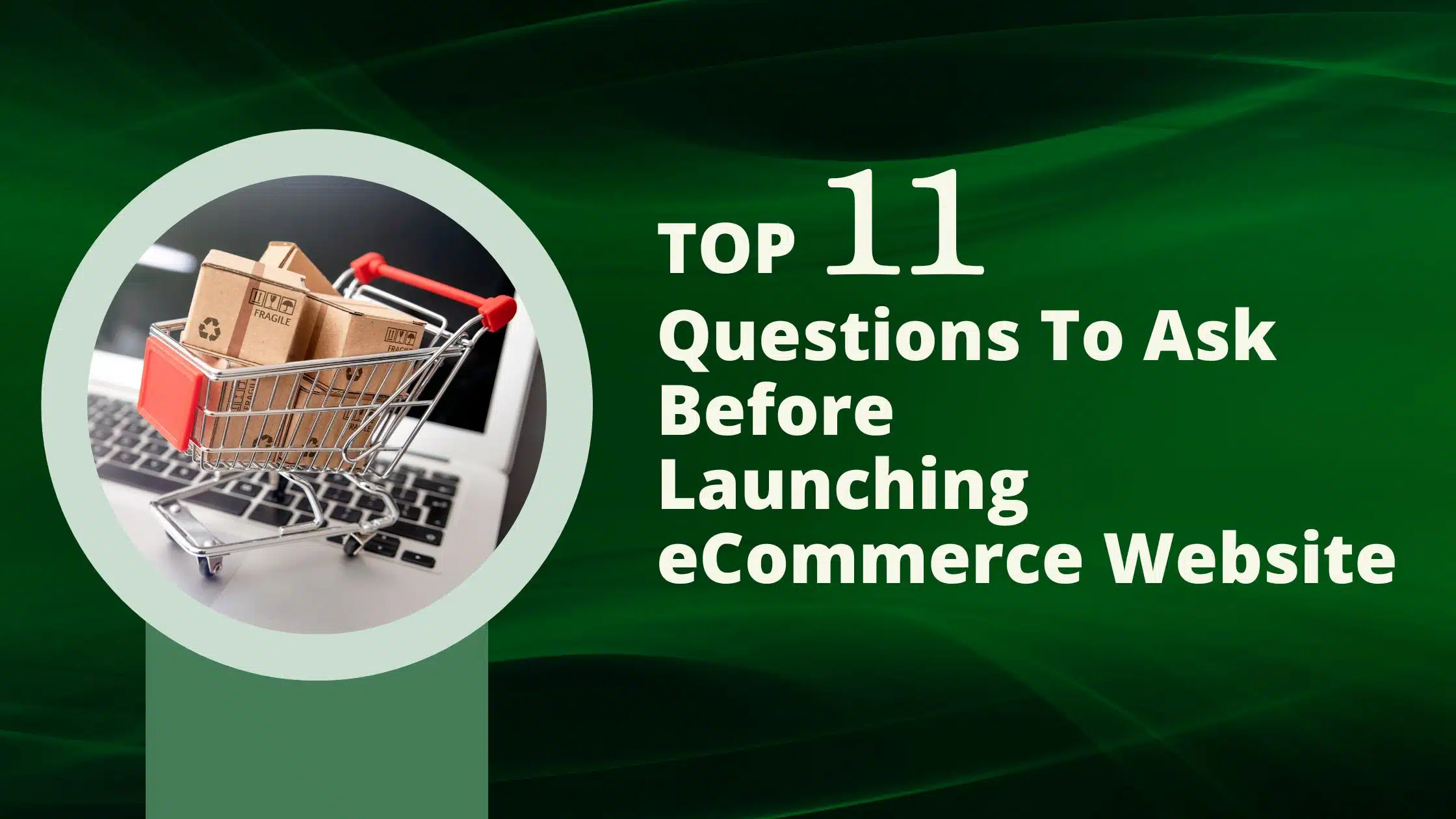Launching an eCommerce website is an exciting endeavor, but it requires careful planning and consideration to ensure success. Before you unveil your online store to the world, it’s crucial to ask yourself the right questions to set a solid foundation for your business. In this beginner’s guide, we’ll explore the top 10 questions you should ask before launching your eCommerce website.
1. What is my target audience?
Understanding your target audience is fundamental to the success of your eCommerce website. Who are your ideal customers? What are their demographics, interests, and online behaviors? Conducting market research and creating buyer personas can help you tailor your website’s design, content, and marketing strategies to effectively reach and engage your target audience.
- Young professionals aged 25-35 seeking stylish yet affordable fashion.
- Parents of young children looking for eco-friendly and educational toys.
- Fitness enthusiasts interested in high-quality supplements and workout gear.
2. What products or services will I sell?
Before launching your eCommerce website, define your product or service offerings clearly. What niche or industry will you focus on? Will you sell physical products, digital downloads, or services? Consider factors such as product quality, uniqueness, pricing, and demand to ensure you’re offering something valuable and competitive in the market.
- Identify a niche market with high demand and low competition.
- Offer unique and innovative products that solve specific customer pain points.
- Curate a selection of high-quality products from reputable brands or suppliers.
- Provide customizable or personalized products to cater to individual preferences.
- Offer digital downloads or subscription services for added convenience and value.

3. How will I source or create my products?
Decide how you’ll source or create the products you plan to sell on your eCommerce website. Will you manufacture your own products, dropship from suppliers, or curate products from other brands? Research potential suppliers or manufacturers, evaluate product quality and pricing, and establish reliable partnerships to ensure a seamless supply chain for your eCommerce business.
- Research potential suppliers or manufacturers and evaluate their product quality and pricing.
- Consider dropshipping options to partner with suppliers who handle inventory and shipping logistics.
- Explore creating your own products in-house or sourcing unique products from artisans or wholesalers.
4. What platform will I use to build my eCommerce website?
Choosing the right eCommerce platform is crucial for the success of your online store. Consider factors such as ease of use, customization options, scalability, security, and integrations when selecting a platform. Popular eCommerce platforms like Shopify, WooCommerce, and BigCommerce offer user-friendly interfaces and robust features to help you create and manage your online store effectively.
- Consider popular eCommerce platforms like Shopify, WooCommerce, and BigCommerce.
- Evaluate ease of use, customization options, and scalability of each platform.
- Compare pricing plans and fees associated with using each platform.
- Research available integrations, plugins, and third-party apps for additional functionality.
- Choose the platform that best aligns with your business needs, budget, and technical expertise.

5. How will I optimize my website for search engines (SEO)?
Optimizing your eCommerce website for search engines is essential for attracting organic traffic and improving your visibility in search engine results pages (SERPs). Conduct keyword research to identify relevant keywords and phrases related to your products or services, optimize your website’s on-page elements such as titles, meta descriptions, and product descriptions, and build high-quality backlinks to improve your SEO rankings.
- Conduct keyword research to identify relevant and high-traffic keywords for your niche.
- Optimize your website’s meta titles and descriptions with targeted keywords.
- Create high-quality, original content that addresses the needs and interests of your target audience.
- Optimize your website’s URL structure to make it user-friendly and search engine-friendly.
- Use descriptive alt tags for images to improve accessibility and enhance SEO.
- Ensure your website loads quickly by optimizing images, minimizing code, and using a fast hosting provider.
- Build high-quality backlinks from authoritative websites to improve your website’s domain authority.
- Optimize your website’s internal linking structure to improve navigation and distribute link equity.
- Regularly update and refresh your content to keep it relevant and engaging for users and search engines.
- Monitor your website’s performance using tools like Google Analytics and Search Console, and make adjustments based on data insights.
6. What payment gateways will I integrate with my eCommerce website?
Offering multiple payment options is crucial for providing a seamless checkout experience and accommodating different customer preferences. Research popular payment gateways such as PayPal, Stripe, Square, and Authorize.Net, and choose the ones that best suit your business needs and target audience. Ensure that your chosen payment gateways are secure, reliable, and compatible with your eCommerce platform.
- PayPal: Offers secure payment processing and supports multiple currencies.
- Stripe: Provides customizable checkout options and seamless integration with popular eCommerce platforms.
- Square: Allows for in-person and online payments with transparent pricing and no monthly fees.
- Authorize.Net: Offers a reliable payment gateway with fraud prevention tools and recurring billing options.
- Braintree: Enables fast and easy payment processing with support for various payment methods and global scalability.
7. How will I handle shipping and fulfillment?
Developing a shipping and fulfillment strategy is essential for delivering a positive customer experience and managing logistics efficiently. Determine shipping rates, delivery times, and shipping methods based on factors such as product dimensions, weight, destination, and shipping carriers. Explore options such as in-house fulfillment, third-party fulfillment services, or dropshipping to find the most cost-effective and reliable solution for your eCommerce business.
- Determine shipping rates, delivery times, and methods based on product dimensions, weight, and destination.
- Explore options such as in-house fulfillment, third-party fulfillment services, or dropshipping.
- Establish partnerships with reliable shipping carriers to ensure timely and cost-effective delivery of orders.
8. How will I market and promote my eCommerce website?
Marketing and promotion are critical for driving traffic to your eCommerce website and generating sales. Develop a comprehensive marketing strategy that includes tactics such as search engine marketing (SEM), social media marketing, email marketing, content marketing, influencer partnerships, and affiliate marketing. Experiment with different channels and campaigns to identify what works best for your target audience and business objectives.
- Utilize social media platforms to showcase products and engage with potential customers.
- Implement search engine optimization (SEO) strategies to improve website visibility in search engine results.
- Launch targeted email marketing campaigns to reach out to existing customers and prospects.
- Collaborate with influencers or bloggers in your industry to promote your products to their audience.
- Run paid advertising campaigns on platforms like Google Ads, Facebook Ads, or Instagram Ads.
- Offer promotions, discounts, or loyalty programs to incentivize purchases and encourage repeat business.
- Create compelling content such as blog posts, videos, or infographics to educate and inspire your audience.
- Participate in online communities, forums, or groups related to your niche to build brand awareness and credibility.
- Leverage affiliate marketing programs to partner with other websites or influencers and drive traffic to your site.
- Attend industry events, trade shows, or exhibitions to network with potential customers and showcase your products.

9. How will I measure and analyze my eCommerce website’s performance?
Tracking and analyzing key metrics is essential for evaluating the success of your eCommerce website and identifying areas for improvement. Set up Google Analytics or other analytics tools to monitor important metrics such as website traffic, conversion rate, average order value, customer acquisition cost, and customer lifetime value. Use these insights to make data-driven decisions and optimize your website’s performance over time.
- Utilize Google Analytics GA to track website traffic, conversion rates, and user behavior.
- Monitor key performance indicators (KPIs) such as average order value and customer acquisition cost.
- Implement tracking codes and tags to measure the effectiveness of marketing campaigns.
- Analyze sales data to identify trends, patterns, and opportunities for improvement.
- Use A/B testing to experiment with website changes and optimize conversion rates.
10. How will I provide customer support and handle returns?
Delivering excellent customer support is crucial for building trust and loyalty with your eCommerce customers. Determine how you’ll handle customer inquiries, complaints, and returns effectively and promptly. Implement a responsive customer support system that includes channels such as email, live chat, phone support, and social media to address customer needs and resolve issues efficiently.
- Implement a responsive customer support system with multiple channels such as email, live chat, and phone support.
- Offer clear and detailed information about your return policy on your eCommerce website.
- Provide a user-friendly process for initiating returns and exchanges, including a dedicated returns portal or contact form.
- Ensure timely responses to customer inquiries and complaints, addressing their concerns with empathy and professionalism.
- Regularly evaluate and improve your customer support processes based on feedback and metrics to enhance the overall shopping experience.
11. How will I ensure website security and protect customer data from potential cyber threats and breaches?
Ensuring website security and protecting customer data is paramount for the success and credibility of your eCommerce website. To address this concern:
- Invest in SSL (Secure Sockets Layer) certification to encrypt data transmitted between your website and customers’ browsers, ensuring secure communication.
- Regularly update your website’s software, plugins, and extensions to patch vulnerabilities and protect against security threats.
- Implement robust authentication and access control measures to prevent unauthorized access to sensitive information.
- Utilize a secure hosting provider with advanced security features and proactive monitoring to safeguard against cyber threats.
- Educate yourself and your team on best practices for cybersecurity and data protection, including password management, phishing awareness, and malware prevention.
- Consider implementing additional security measures such as firewall protection, DDoS (Distributed Denial of Service) mitigation, and intrusion detection systems for enhanced security.
By prioritizing website security and implementing comprehensive security measures, you can build trust with your customers and protect their sensitive information, fostering long-term relationships and business success.
Conclusion:
Launching an eCommerce website requires careful planning and consideration to ensure success in today’s competitive online marketplace. By asking yourself these top 11 questions before launching your eCommerce website, you’ll be better prepared to create a compelling online store that attracts customers, drives sales, and fosters long-term growth and success. Remember to continually monitor and optimize your eCommerce website based on feedback, data, and market trends to stay ahead of the curve and achieve your business goals.
DON’T KNOW WHERE TO START?
If you’re feeling overwhelmed or unsure where to begin, don’t worry – we’re here to help! At Top IT Marketing, we understand that starting an eCommerce venture can be daunting, but we’re dedicated to guiding you every step of the way. Whether you need assistance with website development, digital marketing strategies, or customer support solutions, our team of experts is ready to support you in achieving your business goals. Contact us today at www.topitmarketing.com to schedule a consultation and take the first step towards launching your successful eCommerce website.
FAQ
How much does it cost to develop an eCommerce website?
The cost of developing an eCommerce website can vary widely depending on factors such as the platform used, features required, design complexity, and development team rates. However, a basic eCommerce site can start from a few thousand dollars for a simple template-based solution, while more complex and custom-built sites can range from tens of thousands to hundreds of thousands of dollars. It’s essential to define your requirements clearly and work with a reputable development team to get an accurate cost estimate.
Should I build a custom eCommerce website or use a pre-built solution?
Deciding between building a custom eCommerce website or using a pre-built solution depends on various factors. If your business requires unique features, scalability, and full control over the design and functionality, a custom solution may be the way to go. However, it typically involves higher initial costs and longer development time. On the other hand, pre-built solutions like Shopify or WooCommerce offer quick setup, lower costs, and ongoing support. They are ideal for smaller businesses or those with less complex requirements. Consider your budget, timeline, scalability needs, and desired level of customization when making this decision.
What analytics tools should I use to track the performance of my eCommerce site?
To track the performance of your eCommerce site, you should utilize analytics tools specifically tailored for online businesses. Google Analytics is a popular choice, offering detailed insights into website traffic, user behavior, and conversion metrics. It provides valuable data on user demographics, source of traffic, popular products, and sales performance. Additionally, tools like Kissmetrics, Mixpanel, and Hotjar offer advanced features such as cohort analysis, event tracking, and heatmaps to further understand user interactions and optimize your site for better conversion rates. These analytics tools empower you to make informed decisions, refine your marketing strategies, and enhance the overall user experience on your eCommerce platform.

